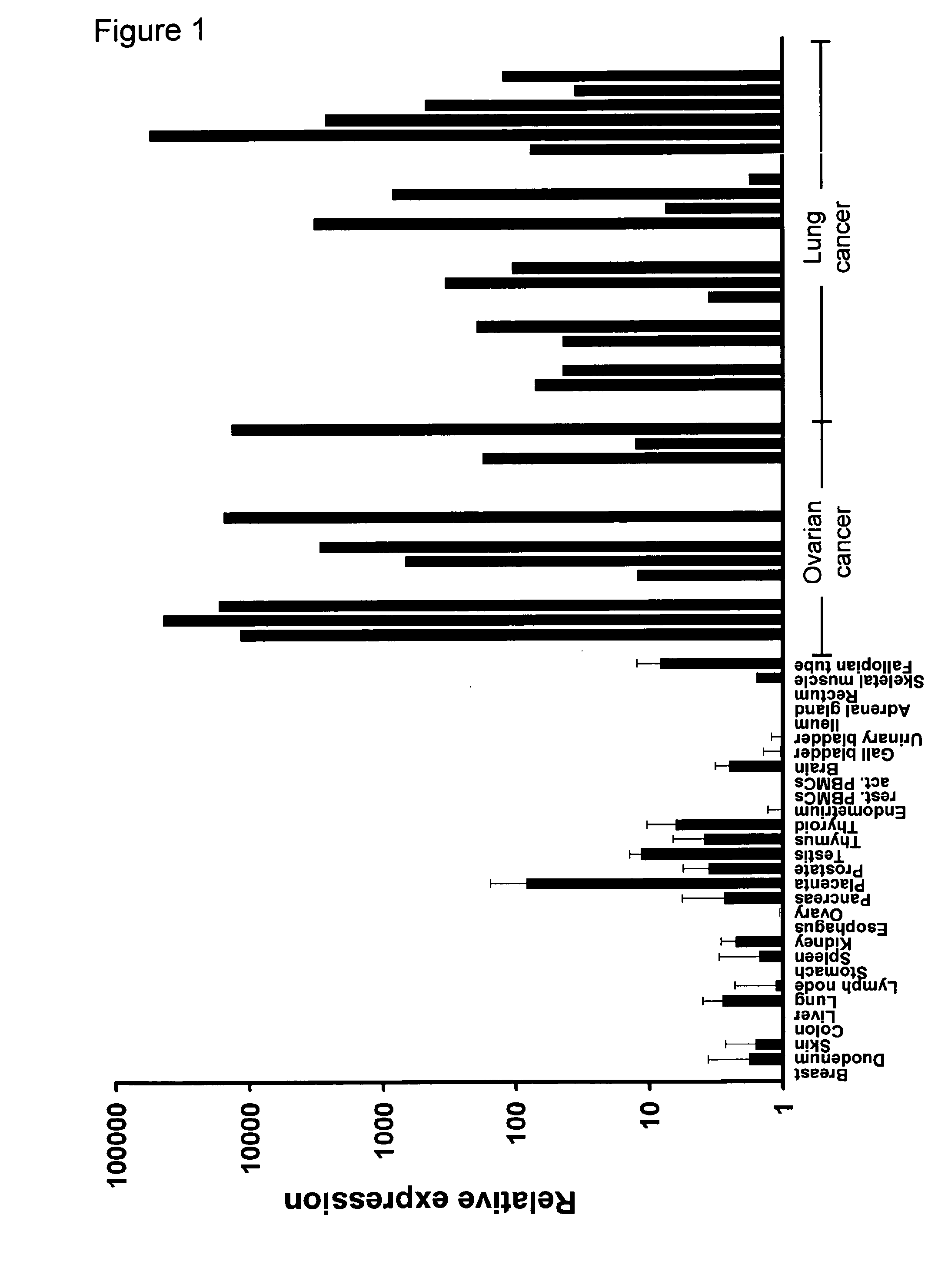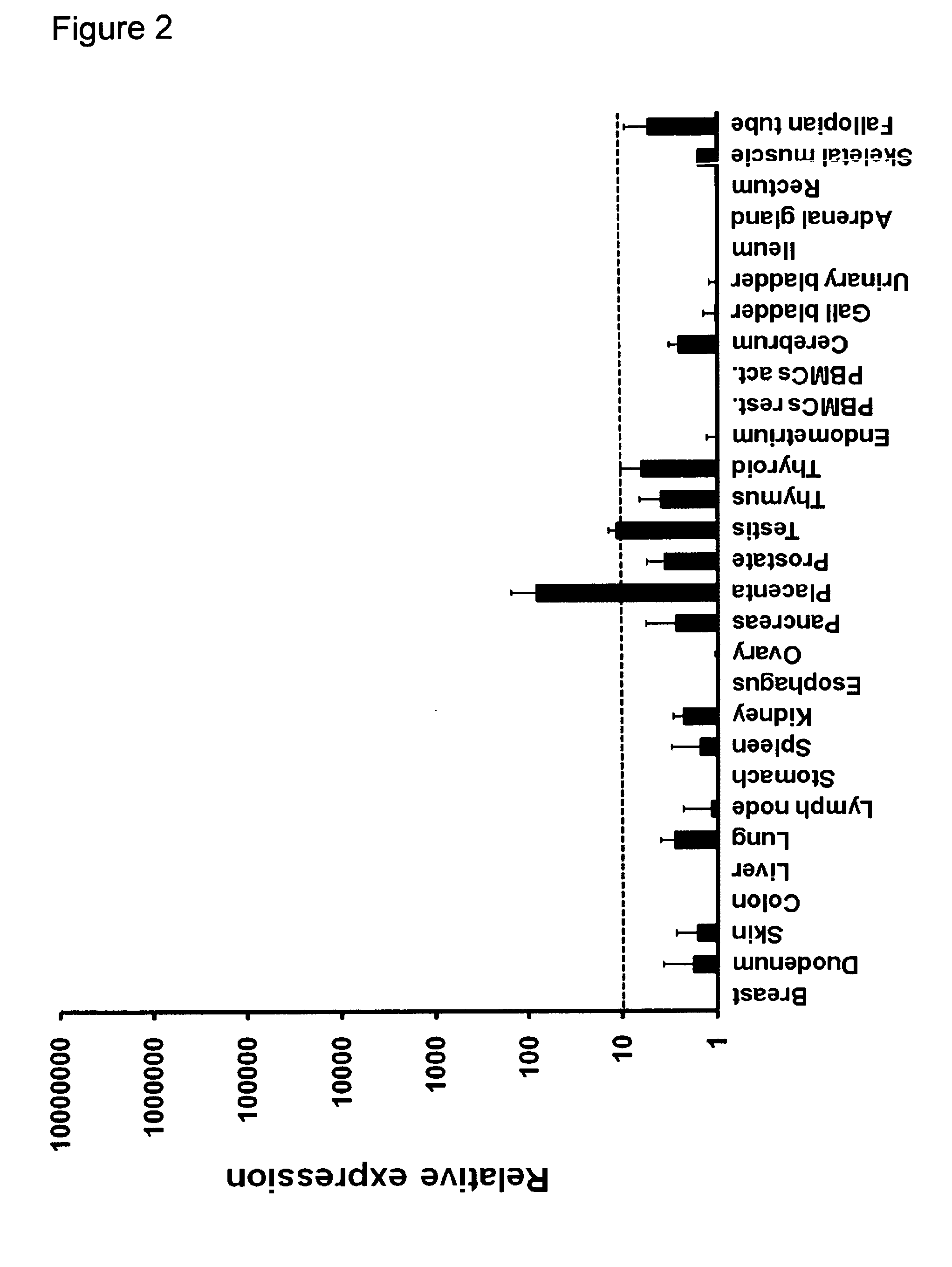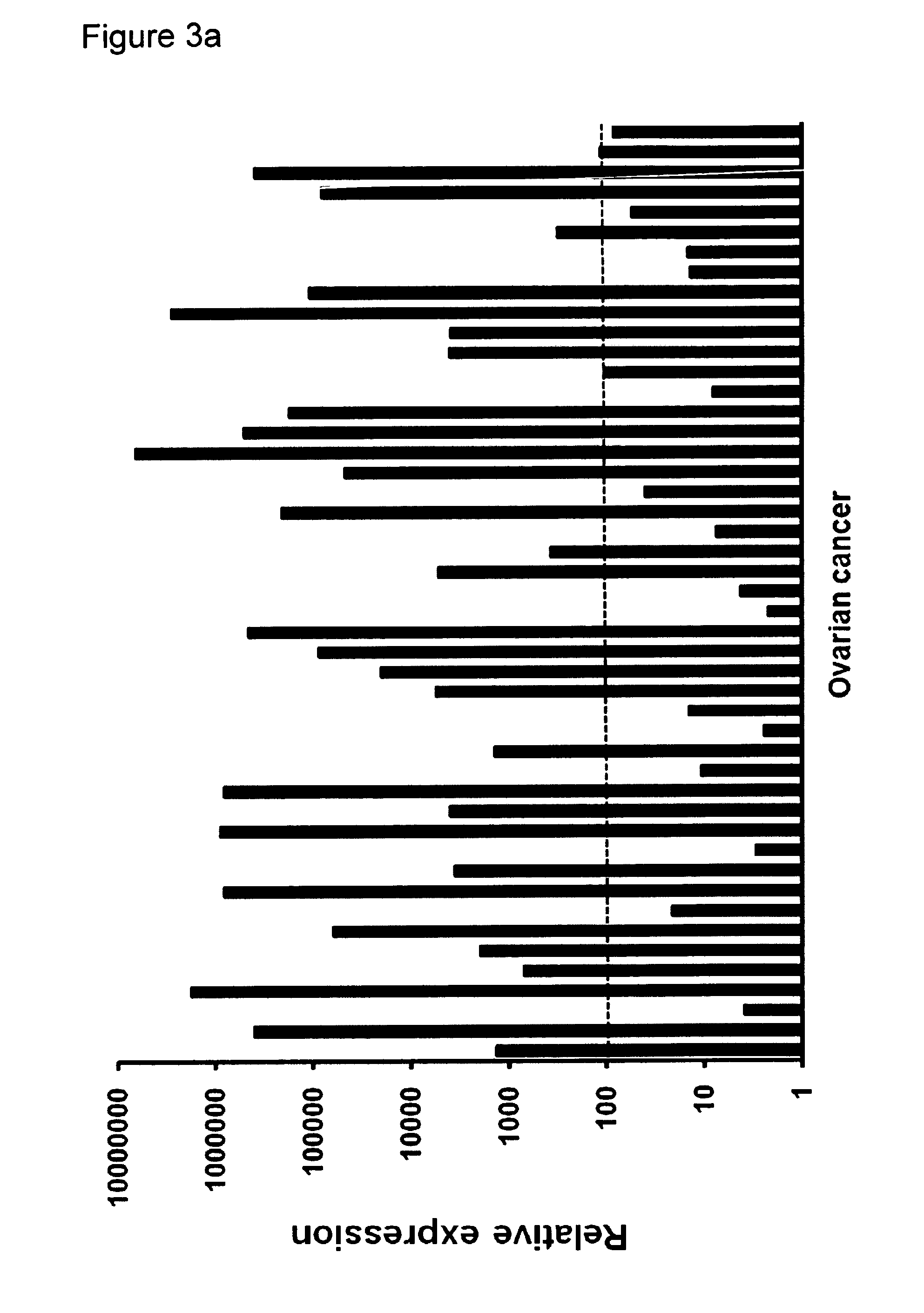Methods and compositions for diagnosis and treatment of cancer
a cancer and composition technology, applied in the direction of dna/rna fragmentation, depsipeptides, fungi, etc., can solve the problems of increased risk of ovarian cancer in older women, increased risk of ovarian cancer in those who use postmenopausal estrogen replacement therapy, and increased risk of ovarian cancer. , to achieve the effect of enhancing stability and/or targeting, facilitating delivery to target sites, and enhancing in vivo stability
- Summary
- Abstract
- Description
- Claims
- Application Information
AI Technical Summary
Benefits of technology
Problems solved by technology
Method used
Image
Examples
example 1
CLDN6 is a Marker which is Specific for Ovarian Tumors and Lung Tumors
CLDN6 (nucleic acid sequence according to SEQ ID NO: 1, amino acid sequence according to SEQ ID NO: 2) expression was quantified in normal tissues and samples from ovarian cancer and lung cancer (adenocarcinomas) using real-time RT-PCR.
For RNA extraction, first-strand cDNA synthesis and real-time reverse transcription-PCR (RT-PCR) were performed as previously described (Koslowski et al, 2006; Koslowski et al, 2007). Real-time quantitative expression analysis was performed in triplicates in a 40 cycle RT-PCR. After normalization to HPRT (sense 5′-TGA CAC TGG CAA AAC AAT GCA-3′; antisense 5′-GGT CCT TTT CAC CAG CAA GCT-3′, 62° C. annealing) expression of CLDN6 (sense 5′-CTT ATC TCC TTC GCA GTG CAG-3′; antisense 5′-AAG GAG GGC GAT GAC ACA GAG-3′, 60° C. annealing) was quantified using ΔΔCT calculation. Tissues from up to three individuals were tested for each normal tissue type.
With the exception of placenta only tra...
example 2
Quantification of CLDN6 Expression in Normal Tissues, Cancerous Tissues and Cell Lines Using Real-Time RT-PCR
Total cellular RNA was extracted from frozen tissue specimens and cancer cell lines using RNeasy Mini Kit (Qiagen), primed with a dT18 oligonucleotide and reverse-transcribed with Superscript II (GIBCO / Lifetech) according to the manufacturer's instructions. Integrity of the obtained cDNA was tested by amplification of p53 transcripts in a 30 cycle PCR (sense, 5′-CGTGAGCGCTTCGAGATGTTCCG-3′; antisense, 5′-CCTAACCAGCTGCCCAACTGTAG-3′; annealing temperature 67° C.). After normalization to HPRT (sense 5′-TGA CAC TGG CAA AAC AAT GCA-3′; antisense 5′-GGT CCT TTT CAC CAG CAA GCT-3′, 62° C. annealing) expression of CLDN6 (sense 5′-CTT ATC TCC TTC GCA GTG CAG-3′; antisense 5′-AAG GAG GGC GAT GAC ACA GAG-3′, 60° C. annealing) was quantified using ΔΔCT calculation.
Tissues from three individuals were tested for each normal tissue type. Only trace amounts of CLDN6 transcripts could be detec...
example 3
Quantification of CLDN6 Expression in Normal Tissues, Cancerous Tissues and Cell Lines Using Western Blot Analysis
For Western blot analysis 20 μg of total protein extracted from cells lyzed with Laemmli-lysis buffer was used. Extracts were diluted in reducing sample buffer (Roth), subjected to SDS-PAGE and subsequently electrotransferred onto PVDF membrane (Pall). Immunostaining was performed with polyclonal antibodies reactive to CLDN6 (ARP) and beta-Actin (Abeam) followed by detection of primary antibodies with horseradish-peroxidase conjugated goat anti-mouse and goat anti-rabbit secondary antibodies (Dako).
Tissue lysates from up to five individuals were tested for each normal tissue type. No CLDN6 protein expression was detected in any of the normal tissues analyzed; see FIG. 4. NIH-OVCAR3, positive control.
In contrast to normal tissues, high expression of CLDN6 protein was detected in samples from ovarian cancer and lung cancer; see FIG. 5. NIH-OVCAR3, positive control.
CLDN6 ex...
PUM
| Property | Measurement | Unit |
|---|---|---|
| temperatures | aaaaa | aaaaa |
| pharmaceutical composition | aaaaa | aaaaa |
| physical examination | aaaaa | aaaaa |
Abstract
Description
Claims
Application Information
 Login to View More
Login to View More - R&D
- Intellectual Property
- Life Sciences
- Materials
- Tech Scout
- Unparalleled Data Quality
- Higher Quality Content
- 60% Fewer Hallucinations
Browse by: Latest US Patents, China's latest patents, Technical Efficacy Thesaurus, Application Domain, Technology Topic, Popular Technical Reports.
© 2025 PatSnap. All rights reserved.Legal|Privacy policy|Modern Slavery Act Transparency Statement|Sitemap|About US| Contact US: help@patsnap.com



